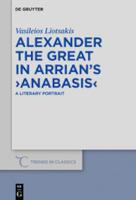
De Gruyter (2019) h/b 284pp £91 (ISBN 9783110658736)
In this meticulous and eye-opening study L. closely re-reads the second-century AD Greek historian Arrian’s Anabasis of Alexander in an attempt to pin down whether, and if so by what literary means and to what ends, Arrian insinuated a personal interpretation of Alexander into his work. The methodological difficulties of pursuing such an investigation are considerable, chiefly because Arrian’s authorial voice is rarely explicitly distinguishable from that of his sources. Since L. ends up making a persuasive case, this study marks an important advance in Arrian-scholarship, which has tended to see the Anabasis as a work of compilation or even epitomy marked—so e.g. Peter Brunt—by its author’s ‘absence’.
L. organises his treatment into four chapters each offering a detailed textual investigation of a particular theme. Chapter 1 (‘Overall Design: From Praise to Criticism’) presents the main thesis, namely, that Arrian deliberately heaps up praise of Alexander in the first three books, before inserting a ‘pivotal’ digression near the start of the fourth (4.8-14). This gathers various episodes intended to illustrate Alexander’s increasing arrogance and vanity. The evolution of Alexander’s morality Arrian attributes, not to the corrupting influence of Asia, but to Alexander’s ‘great successes’ (4.7.5: megala pragmata, meaning military achievements). The remainder of Arrian’s chronologically linear narrative then intrudes further notes of criticism, notably of the Indian campaign and its cruelty, although the overall judgment on his subject remains favourable to the end.
In the next two chapters, respectively ‘March-Narrative and Characterization’ and ‘Atemporality and Characterization,’ L. analyses the nitty-gritty of Arrian’s narrative techniques. These include framing, omission, repetition, and temporal displacement, wielded, L. argues in detail, not as random choices but systematically. He shows, for instance, that Arrian was aware from his sources of mounting Macedonian discontent with Alexander’s ‘Persianizing’ and divine pretensions, but deliberately deferred introduction of these topics until Book IV and the events of 329/8 BC. Similarly, the helmet filled with water, inserted into the account of the Gedrosian desert, probably occurred four years earlier (as Arrian admits, 6.26.1) in Hindu Kush, where it would have been out of place, L. believes, since Arrian there sought to present Alexander as engaged in ‘a romantic effort to punish Darius’ murderers’ (131). Finally, chapter 4 (‘Arrian Homericus: Alexander, the Epic Hero’) tackles Arrian’s handling of a theme already entrenched in the Alexander-sources of the day, judging that Arrian deliberately refrained from going as far as some predecessors such as Callisthenes, who was at pains to emphasise the ‘flattering associations of places visited by Alexander with Homeric sites’ (215). One factor in this relative restraint was the contemporary critique of excessive mixing of poetic embellishments into history-writing (so Lucian in How to Write History).
In his Conclusion L. offers a fascinating rationale for Arrian’s original view of Alexander: Arrian saw him as a ‘protector of order and culture’ who laid ‘the foundations of the Greco-Roman dominion in the East’—until he sought to conquer peoples classed in Arrian as ‘already virtuous and civilised’ (the Indians notably). Arrian’s perspective, in other words, was that of a Roman senator and vir militaris (and certainly not, one might add, that of a provincial Greek man of letters writing in covert criticism of Roman power).
L.’s book contains rich pickings both for historians and for students of ancient historiography, constituting a reminder to the former—if one is needed nowadays—of the often rhetorical quality of the latter. Despite L.’s manifest ease in the milieu of ‘literary theory and the classics,’ the book is readable and surprisingly jargon-free. Its originality makes it a landmark in its field of study.
Tony Spawforth
Brighton
